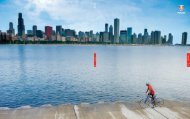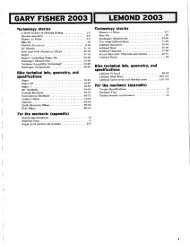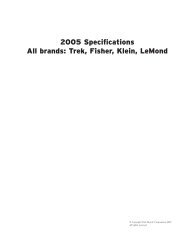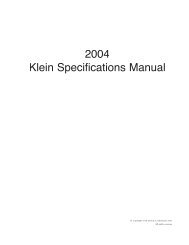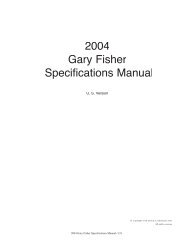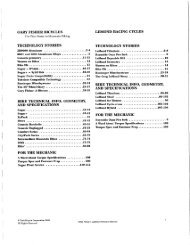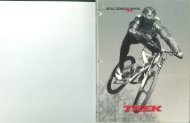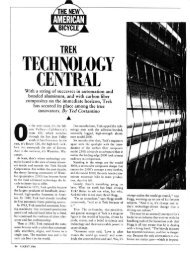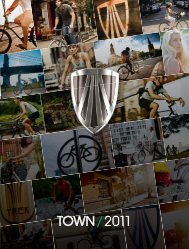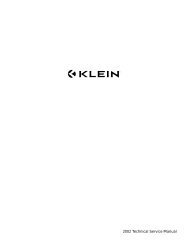TECHNOLOGY STORIES BIKE INFO, GEOMETRY ... - Vintage Trek
TECHNOLOGY STORIES BIKE INFO, GEOMETRY ... - Vintage Trek
TECHNOLOGY STORIES BIKE INFO, GEOMETRY ... - Vintage Trek
You also want an ePaper? Increase the reach of your titles
YUMPU automatically turns print PDFs into web optimized ePapers that Google loves.
agents containing petroleum. Hydraulic fluid can also<br />
contaminate the brake. Any time you are going to clean<br />
the bike or bleed the brakes, make sure the wheel is<br />
removed, and also remove the brake pads (place something<br />
between the pistons to prevent them from hyperextending<br />
if the lever is applied).<br />
With rim brakes, pad wear is usually easy to see, even<br />
from a distance. This makes it easy to monitor pad wear.<br />
With a disc brake, the pads are inside the caliper, so<br />
they require a little more vigilance. Replace disc brake<br />
pads if they are less than 1mm thick.<br />
A few words about new brakes<br />
When a disc brake is brand new, it’s likely that they<br />
will not stop really well. This is because the rotor is<br />
steel, and the new brake pads do not exactly conform to<br />
the smooth surface of the rotor. As the brakes “burn in”,<br />
pad material is transferred to the rotor on a microscopic<br />
level. As this occurs, the brake pads will wear to exactly<br />
match the surface of the rotor. Also, pad material will<br />
be embedded in the rotor, and the coefficient of friction<br />
goes way up.<br />
Before providing a test ride on a bike with new disc<br />
brakes, explain to the customer that full stopping power<br />
will only happen after a dozen or so hard, hot stops<br />
have fully burnished, or bedded in, the rotor and pads.<br />
During this burn in time, it’s best to avoid wet weather<br />
riding which may impede the burn-in process.<br />
Cable operated mechanical disc brakes<br />
The new generation of cable operated, mechanical<br />
disc brakes work really well. They can be tuned<br />
to provide good feel and modulation, and meet the<br />
expectations of riders who are accustomed to rim<br />
brakes in regards to feel and lever travel prior to pad<br />
contact. They can even be made to match the feel of a<br />
V-type brake used on the rear, if so desired. However,<br />
even though the two feel the same at the lever, the<br />
mechanical disc brake will stop better once the rotor<br />
is burned in.<br />
So if they feel the same, what’s the benefit? The disc<br />
brake will stop better, works in all conditions, is easy to<br />
adjust and maintain adjustment, and does not wear the rim.<br />
Full Hydraulic disc brakes<br />
The full hydraulic disc brake is the most powerful<br />
of the brakes we spec. This extra power exists even<br />
when the rotor and brake pads are identical between a<br />
mechanical disc and hydraulic disc. It’s thought that the<br />
difference is mostly cable friction and housing compression.<br />
It probably also is the result of differences in<br />
mechanical advantage, and the need for return springs<br />
on the mechanical brake.<br />
Some experienced riders do not like the feel of full<br />
hydraulic brakes due to their very short lever throw.<br />
People experienced with motorcycle brakes say this is<br />
how brakes should be. Why the difference? With a rim<br />
brake, it’s necessary for the brake to open a large distance<br />
for the rim to allow debris or mud to pass by, or<br />
to allow an out-of-true wheel to rotate freely. With a disc<br />
brake, these are not issues. So instead of wasting time<br />
moving the lever a long ways prior to pad contact, a full<br />
hydraulic brake gives almost instant response. They still<br />
offer reach adjustment, so the lever can be adjusted so<br />
the stopping power is applied where the hands have the<br />
most strength.<br />
Some riders object to full hydraulic brakes because<br />
they simply do not understand them. They have a com-<br />
<strong>Trek</strong> 2002 Tech Manual<br />
fort level with the traditional brake cable and housing.<br />
For these riders, it’s important to explain that hydraulic<br />
brakes do not have to be bled all the time. Bleeding<br />
is normally only necessary when the fluid has been<br />
degraded due to heat over a period of time, which on a<br />
bike would normally be several years. And actually the<br />
whole bleeding procedure is fairly simple.<br />
Lastly, if the extra stopping power isn’t enough of<br />
an advantage, full hydraulic brakes are actually lighter<br />
than most cable operated disc brake systems.<br />
Disc brake squeal and other issues<br />
Disc brakes on a bike, like those on a car, can make<br />
noise. Noise, in its rawest sense, is the vibration of<br />
air molecules. The air molecules are usually excited<br />
by something else vibrating, and in the case of brake<br />
squeal the start of the vibration is one of the brake<br />
parts. But which one?<br />
The first thing to check with squealing disc brakes<br />
are the myriads of bolts. Check that all the bolts are<br />
properly tightened; rotor attachment bolts, brake attachment<br />
bolts, and bolts holding an adapter to the frame.<br />
Another source of vibration is between the brake<br />
pads and the rotor. This can be caused by debris, chemical<br />
contamination, or simply misalignment. Debris can<br />
mean anything picked up from the trail. Dust can make<br />
discs squeal, and so does water.<br />
Chemical contamination can come from chain lube,<br />
brake fluid, or any number of other sources. In the case<br />
of chemicals, they may impregnate the disc brake pad<br />
material or the surface of the rotor. This can be very<br />
hard, or impossible, to remove. If the contamination<br />
cannot be removed, the only solution may be to replace<br />
the parts. For this reason, its very important that you<br />
remove the rotor (remove the wheel) and pads prior<br />
to bleeding the brakes so brake fluid does not contaminate<br />
them (place something between the pistons<br />
to prevent them from hyperextending if the lever is<br />
applied).<br />
Misalignment can come from several sources. First,<br />
check that the dropouts of the frame are parallel. Then,<br />
with the wheel inserted in the frame and the quick<br />
release properly closed, check the brake adjustment. If<br />
the pads do not meet the rotor evenly, some vibration<br />
may occur prior to both pads making contact. If the<br />
pads do not meet the rotor squarely, in all three planes,<br />
some vibration may occur. Disc brakes do not allow<br />
3-plane adjustment, but do the best you can. Ultimately,<br />
it may require that the pads wear-in slightly before<br />
their surface is truly in alignment with the rotor.<br />
A less obvious source of vibration is air bubbles in<br />
the brake fluid. Brake fluid is essentially not compressible,<br />
but air is, If the brake pad vibrates while air is<br />
in the system, the air will more easily allow the pad<br />
to vibrate, enhancing any resulting noise. Even a tiny<br />
amount of air can be a problem, so don't rely on lever<br />
feel to tell you if there are air bubbles in the oil.<br />
Its possible for the brake to vibrate, even with<br />
everything properly adjusted. Its a matter of the<br />
coefficient of friction of the pad against the rotor<br />
occurring at just the right frequency. In our experience,<br />
this only happens with certain brakes and certain<br />
pads. We have designed a 'brake booster' for disc<br />
brakes which quiets this.<br />
Note: We recommend that disc brakes only be serviced<br />
by your dealer.<br />
23




